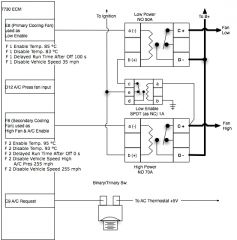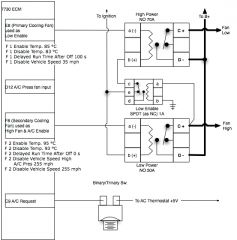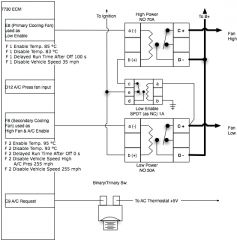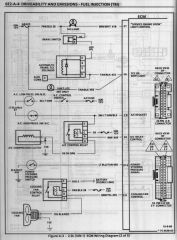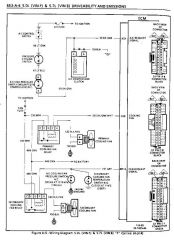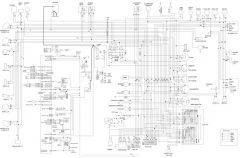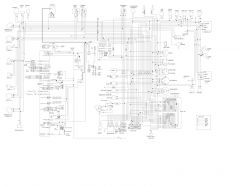-
Posts
497 -
Joined
-
Last visited
-
Days Won
2
Content Type
Profiles
Forums
Blogs
Events
Gallery
Downloads
Store
Everything posted by strotter
-

Wiring questions?? '77 280Z to '90 TPI & T-5
strotter replied to sstallings's topic in Gen I & II Chevy V8 Tech Board
OK, there's a typo; the "High Fan" and "Low Fan" note at the right side of the sketch, as well as those below the relays, are backwards: the upper wire & relay feeds the low-speed circuit, the lower wire and relay feeds the high-speed / a/c circuit. It *should* look like this: I *think* that fixes the problem you're talking about. I can't believe I let that slip by; it's in my wiring diagram, too. Should I go back and change the link to the erroneous picture, so future readers aren't confused? Also, I've confirmed that the blue wire running to the compressor clutch from the binary/trinary switch is the *only* wire running there; I'm assuming it's +12V and the clutch grounds through its' mount. So does it look it'll work now? -
-

Wiring questions?? '77 280Z to '90 TPI & T-5
strotter replied to sstallings's topic in Gen I & II Chevy V8 Tech Board
I normally don't like to do "I'm gonna -" posts, as they seem never to come to pass, but I'm making an exception here because others are doing the same work right now, so I thought I'd share as soon as I had even a working idea. OK, I've been working on this thing, trying to use all the functionality GM built into the 7730 ECM, while keeping the parts count as low as possible. I did some research (mostly here) on different wiring setups for different models. I finally came on the simplest of all, for an '87 Corsica/Beretta 2.8, 3spd automatic. Here it is: As you can see, this is a pretty straightforward setup, so I used it as inspiration. I came up with a simpler relay logic circuit than deja's, using two big relays and one small. I can get away with this because most of the system's operation is controlled by the ECM - there is no physical connection between the a/c system and the fan control system. This setup also uses the "primary" circuit to drive the fan at low speed, and "secondary" fan control circuit to drive the fan on high. When the high-speed circuit comes on, though, the little SPDT relay in the middle (used as "Normally Closed") opens and disables the low-speed circuit. The ECM "knows" when the a/c is on when the binary switch closes, via C9 going high. This part is similar to what Vintage Air shows on their wiring diagrams, though they drive a relay for the fan motor. I am a bit concerned abut this - it might cycle the fan on and off quite a bit, stumbling the engine each time. We'll see - I think I can tune it out for most conditions. If it's a problem, I'll use some other hot wire in the Vintage Air system, so as to keep the C9 signal high the whole time the a/c is on. The tuning logic is below the appropriate pins. The a/c "off" logic I'm starting with is as follows: the low-speed primary comes on at 85°C (180°F). As the coolant gets hotter, the high-speed secondary comes on at 95°C (203°F). When that happens, the hot wire from the secondary energizes the little relay, opening the contact and shutting off the signal from the ECM to primary relay, which de-energizes. All happy. The a/c "on" logic is: the secondary is turned on with the a/c, fan is on high. When the a/c cycles off, and if the coolant is below 85, the fan shuts off with the compressor clutch. When the temp gets above 85, instead of shutting off with the compressor the fan drops from high speed to low, maintaining cooling. If the temp should continue to rise above 95, it stays on high regardless of the compressor clutch state. I'm sure there will be changes before I'm done, but I think this might be a workable system. Any critique or suggestions would be greatly appreciated. -
-
One of the nice side-effects of leaving it centered is that you can replace the hood w/o modifying it.
-

Wiring questions?? '77 280Z to '90 TPI & T-5
strotter replied to sstallings's topic in Gen I & II Chevy V8 Tech Board
Like I said man, this is the part that's most fun - figuring stuff out, making it work, making it elegant. I've been working on a new wiring diagram using OmniGraffle, a general purpose diagramming program. It includes all the same components as before, but I've added all the little "goodies" that have been added over the years - the wideband, the a/c system, the audio gear, modifications to the instrumentation, so on. And, I've actually gone out to my car and confirmed the colors of the wires ('cause the indicated colors of some appear to have been randomly mixed in the factory diagrams). I'll post a copy of it when it's workable. Have fun! W/R/T the trinary switch - I think, when it's done, I won't be using the "trinary" part of the trinary switch, only the plain old "binary" part. The trinary switch is just two switches in parallel rather than one, BTW. I don't think both will be needed. That functionality will come (I think, it's all in the details) from the ECM itself. Has yet to be determined. -
Thanks. I've ordered a couple of the "quiet" electronic ones.
-

Wiring questions?? '77 280Z to '90 TPI & T-5
strotter replied to sstallings's topic in Gen I & II Chevy V8 Tech Board
Sorry about that Steve, but the different ECMs use different pin designations. I was just going with deja's pinouts. The 7730 setup (and documentation) isn't as straightforward as deja's ECMs is. The 7730 uses GE8 (labeled "cooling fan") for the primary cooling fan. However, the secondary fan operation is more circumspect; the factory didn't use the ECM to trigger the secondary fan. Here's the relevant "factory" circuitry from a '92 TPI Camaro: This is a pretty low-res image, but it should be readable. Though it looks like it, the ECM does not turn on the secondary via BD12; they instead used a thermal switch in the block, or the a/c pressure switch, to trigger the fan. Also, BC9 at the top doesn't turn the a/c on, but only tells the ECM the a/c has been turned on (so as to kick up the idle). BD12 has (I believe, could use some clarity here) a similar function with regard to the secondary fan. However, some research turned up a couple of descriptions of the pinouts indicating that another pin, F8, is indeed the secondary fan control - it had to be there, 'cause the Corvette 7727 ECM (which is a weather-tight '7730) directly activates the fan from the ECM via relay. Identifying which pin was the only problem. This is a post over at ThirdGen from an experienced ECM guy (much more so that I, and who has a gorgeous Camaro BTW) who experimented a bit and confirmed this setup. You'll need to repin your connector to gain that functionality, but it's not really a problem if you have a "pinning" tool. EDIT: They actually *do* act like switches, though with no moving parts. To "go high" or "pull high", a terminal provides some voltage, be it 5v or 12v or whatever - its' electrical state is at a positive potential. It's as if a switch connected to the battery is closed. What happens then depends on what it's hooked up to. To "go low", it grounds (or sometimes provides -5V or -12v or whatever), or is at a "ground state" potential. Same as the other, what happens depends on what it's attached to. When you say a transistor is "high", though, can mean either that it's held at some positive voltage *or* that it has no electrical state at all - called "floating". That's not normally done. In the diagram above, for instance: if you look in the middle of the picture at the primary fan control, you'll see that the relay's low amperage connectors "D" and "F" are attached to +12V and the ECM, respectively. The +12V can't do anything until there's some place for it to "go", which is what the ECM provides when it wants the fan spinnin' - it provides a ground ("goes low" or "pulls low") for the current to flow through. Electricity flows from the 12V source (Ignition, Fan Fuse, 250 brown wire) to the relay, thence to 335 DK GRN WHT and pin E8 to the ECM. Needless to say, the computer can't handle a lot of amperage, which the relay itself handles. If the ECM *could* handle lots of power, you could just run a wire from the battery, to the fan "positive" connector, then from the fan "negative" connector to the ECM and be done. A not-bad way to think of it is: there's a little switch attached to each of the pins. The computer can open or close each switch. The only thing you really need to worry about is whether the switch is attached to + or -. Really. That's enough. It's what I do. I don't know doodly-squat about transistors or impedence or heat sinks. I just have a mental picture of lots of little switches, with tiny robot fingers opening and closing them. Some are attached to ground, some are attached to the battery, some send signals to the computer. I can modify when the computer opens or closes these switches, and that's all I need to know to tune. Beyond that, my electrical thinking is along the lines of "water flowing through a pipe". Also, remember that modern electrical systems are so complex that they are designed (and built and repaired) as systems. You only need to worry about one system at a time, unlike older systems with were more integrated. Deal with the one system you're interested in, get it working, then move on to the next. They are *almost* entirely independent, and can be treated as such one at a time. -
-
This was covered some time ago here. Scroll down to post #34. My impression at the time was that the 240 bushings were too narrow, the 280 too wide. Also, some research (post 46, same thread) showed that this problem is not new, nor has it only to do with any particular brand: From post #46, I ended up making some spacers: Simple fix!
-

Wiring questions?? '77 280Z to '90 TPI & T-5
strotter replied to sstallings's topic in Gen I & II Chevy V8 Tech Board
I appreciate that, Steve. I'm paranoid about stepping on other people's toes, thread-wise. We're all learning new stuff all the time, and I've found it's best not to put off pertinent questions until later "Ask now, let the mods clean it up" kind of thing. If you have any '7730 (second generation) ECM questions, don't hesitate to start a thread or PM me. I'm in the middle of some of this stuff myself (have been for a couple of years, to tell the truth). -

Wiring questions?? '77 280Z to '90 TPI & T-5
strotter replied to sstallings's topic in Gen I & II Chevy V8 Tech Board
Deja, I believe their trinary pressure switch does this. Check here. BTW, I think we hijacked this thread. Sorry Steve. -

Wiring questions?? '77 280Z to '90 TPI & T-5
strotter replied to sstallings's topic in Gen I & II Chevy V8 Tech Board
Deja, that's awesome. I'm comfortable with the digital end of things, but the actual wiring a bit out of my element. So help me interpret the logic here. From cold motor, with a/c "OFF": A10 is high, A11 is high, both Primary and Secondary Coolant Fan Relays are open, the top New Relay (1) is closed, lower New Relay (2) is open; coolant temp increases to Fan 1 Enable Temp., A11 goes low firing the Primary Cooling Fan Relay. This pulls D4 up, which passes through the "Normally Closed" new relay 1 which puts high amperage current to the Taurus fan motor's "low speed" winding. Engine then gets hotter until it reaches Fan 2 Enable Temp. A10 goes low, setting the Secondary Cooling Fan Relay pulling F1 up. This triggers BOTH new relays, opening 1 (shutting off the low-speed power) and closing 2 (turning on the high-speed power) at the same moment. Now, from cold motor with a/c "ON": A10 is low, A11 is high; so the Secondary Fan Relay is closed, sending current to both of new relays opening 1 and closing 2. High current goes via New Relay 2 to the fan high speed windings. Temp increases to Fan 1 Enable Temp (probably not, 'cause that fan's already spinnin' but let's say), A11 goes low dropping the Primary Cooling Fan Relay. D4 still goes high, but nothing happens beyond that because New Relay 1 is already open. Is that about right? [edit for clarity]: for those that don't know, A10 and A11 are ECM pins. A10 "goes off" strictly relative to engine temp - somewhere a bit above 100°C from the factory, though that can be adjusted in a variety of ways. A11 is different in that it fires under two conditions: 1) when engine temp gets even higher, such as 150°C, and 2) when the a/c is turned on. Its parameters can be edited, too. The factory setup for one of the late-90's ECMs are like this: Fan 1 Delayed Run Time After Off 100 s Fan 1 Disable Vehicle Speed 35 mph Fan 1 Disable Temp. 104.75 °C Fan 1 Enable Temp. 107.75 °C Fan 2 Delayed Run Time After Off 0 s Fan 2 Disable Vehicle Speed High A/C Pres 255 mph Fan 2 Disable Temp. 151.25 °C Fan 2 Disable Vehicle Speed 255 mph Fan 2 Enable Temp. 151.25 °C -

Wiring questions?? '77 280Z to '90 TPI & T-5
strotter replied to sstallings's topic in Gen I & II Chevy V8 Tech Board
This would be an excellent way to do this - certainly the most integrated - and has the added advantage that you can "bump" the engine idle RPM when the a/c kicks on; thus you can "tune" the output of the a/c system at idle, when it's most challenging anyway. I'm as we speak (well, gradually ) installing this wiring into my ECM (a GM '7730 / Vintage Air / 2-speed Taurus). -
Can I simply replace the factory turn-signal relay with any old 2-wire replacement (such as this guy), or is there some special electrical voodoo I have to take into account?
-

Wiring questions?? '77 280Z to '90 TPI & T-5
strotter replied to sstallings's topic in Gen I & II Chevy V8 Tech Board
You're in the middle of the best fun you'll ever have working on the car. I'm a fool for the detail-ee stuff like this. I made a wiring diagram for my swap (originally a GM '7747 ECM into my '72). I copied a Z diagram into a graphics program, deleted the old bits, modified it more to make some room, then grafted in the ECM and related parts. Mostly I was trying to figure out the details of what went where, electrically speaking. The above is a "low resolution" image, the high resolution is here. I don't know how readable it might be for you; if it's a problem, please email me and I'll send you a .pdf that's quite a bit clearer. A couple of things to note here: the "style" of the original Z diagram and that of the newer wiring diagrams is quite a bit different. Older diagrams more-or-less showed you every wire in the car on the same page, which was slow to read but very comprehensible. Modern diagrams tend to display "systems" or groups of functionally related wiring together, with the different systems on different pages. I prefer the former, even if it's a little hard to read, as may be obvious from the image, so I just "shoved" the new style into the old. For instance, the "new" part of the diagram has wires ending in the middle of nowhere, with a note "switched 12V" at the end, indicating that "this wire goes to a source of 12V that comes on when the key is on, somewhere". Things like that. Also, the whole ECM and the related stuff is powered via an oversized "ignition" relay, which is functionally the same as the original but quite a bit heavier (a Bosch 70A, yeah I know it's overkill). An exception to this is the power leads to the relays, which I fused separately and also didn't show. Also, I put the whole (abbreviated) EFI system on a single backplane, a chunk of aluminum about 12" x 14", so I could ground it all right there, as well as get to it all easily. It was originally under the passenger seat, but has now been moved to the passenger footwell behind a "false firewall" that hinges down for access. You'll surely need to create something like this for your swap, with different details, depending on how much of the Datsun wiring you choose to keep, though GM ECM's of that period are all very similar. Any questions, email, I'll try to help (though I won't promise to be prompt). Good luck and have fun. -
-
This is the wiring diagram I created for my (original) swap of a GM '7747 ECM into my '72 Z. I basically copied an original Z diagram, modified it, and then drew in the necessary parts of the ECM diagram. Note that all switched (+) power for the system comes from a central distribution terminal dedicated to the ECM, except for hot leads (generally heavy loads) to relays, which are separately fused (though that's not really shown - sorry). This distribution is shown in the same way that GM did it, with a note "switched" at the appropriate spots. I was mostly interested in debugging the simplified ECM wiring. Currently I'm running a '7730 ecm, which uses different pins on the ECM, though they generally have the same names (and functions). I didn't have to change any sensors out for that modification.
-

It's been a VERY sad week here - A message to my "Friends"
strotter replied to Warren's topic in Non Tech Board
My deepest condolences. -
How about a "digital" watch with no digital components? Mechdigital? Digichanical?
-
Try http://www.surfthechannel.com/; for the Top Gear stuff here. Not everything is accessible all the time, nor are some of the episodes accessible at all, and you'll get used to the "buffering" popup. If you can find a "transparent proxy" server in the UK (try a search for that term, there are lots of sites that keep track of them), and you're lucky, you can get the BBC online feeds directly a couple of hours after they're broadcast at http://www.bbc.co.uk/iplayer/. Note that you don't want to configure your system (or browser) to use the transparent proxy server all the time, as you'll be routing all your traffic through Cardiff or something; I use Safari for general browsing, as it uses my "system" configuration through my normal ISP, and Firefox (which keeps its own settings) for watching iPlayer. It's only a once-in-a-while thing, I don't think BBC will mind much.
-
Your picture isn't coming up for me, but I assume there's a hole in the hose? Hey, drilling something important isn't that hard to do - but don't ask me how I know. Anyway, a lot of a/c shops can replace the hose for just a few bucks, if you can't find one cheap. Around here (central California), there's a place calls itself a "radiator" shop, replaced a 2' length of hose for me for, iirc, less than $20. If it's the fitting, that can be replaced, too.
-

Finally got me a new bike!! Bite me gas prices!!
strotter replied to Slammed68's topic in Non Tech Board
There's a young woman who leaves for work every morning about the same time I do. She rides a Suzuki (600, I think), and wears full leathers, purple and pink. Long reddish hair in ponytail. She's small, too, and when she comes to a stop has to stretch *way* down to get her tippy-toes to the ground. There's a certain - mmm, "shape" - she makes when she stretches. Visible from the rear. Mmm, shape. This is why I'm not sure what kind of bike it is. Just sayin'.

